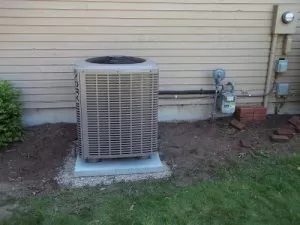A heating system generates heat through ignition or organic resources. If you have a furnace-type heating system, your home generates its own heat through combustion components.
Ignition-based heating facilitates fuel induction and burning. Inducing gas, oil, and other fuel risks leaving behind residue. A furnace typically has a built-in safety feature because pressure, fuel, and fire make a volatile mix.
A furnace flame sensor prevents a gas leak from saturating the surrounding environment. A bad flame sensor will allow a surplus of gas to seep out of your furnace into the surrounding environment. Enough carbon buildup may expose you to dangerous levels of unburned gas that may cause carbon monoxide poisoning.
Familiarizing yourself with all your heating and air conditioning components will help keep your entire family safe.
Get to Know Your Furnace Flame Sensor
Why do so few of us know more about a flame sensor with it playing such an important task? Where is it? What is it? How does it look? Is it removable? Do you need to replace the sensor?
Remember, the furnace flame sensor plays a critical role in your safety. However, it isn’t a dominant fixture in your furnace. You might not notice it if you don’t know what your furnace is looking for.
The flame sensor is a thin metal rod-shaped device within the burner assembly. It sits atop, below, or beside the pilot light.
What Does the Furnace Flame Sensor Do?
A flame burns fuel such as gas or oil. Most furnace flame sensors automatically shut off the gas valve when the flame light goes out, ensuring the efficient utilization of your gas supply.
While it is a great integration for cost-efficiency, the furnace flame sensor is a safety feature that keeps unburned gas out of your airways. Your heating system may be linked to your HVAC system through a series of ductwork.
Ambient gas in the rest of your living spaces is hazardous. If your gas furnace is in the basement or crawl space, gas may still creep into heating vents and make it to the rest of your air conditioning system.
Furnace Flame sensor and control box
The furnace flame sensor is only a sensor. A single wire attached to the flame sensor sitting within an open fire chamber, and control box, allows the former to command the rest of the furnace.
Here’s what that process looks like:
- The flame sensor detects temperatures.
- The flame sensor reacts to the temperature drop.
- The sensor sends signals to the control box.
- The control box trips the gas valve and cuts off the supply line.
- The process shuts down your furnace completely.
The control box cannot detect temperatures. The furnace flame sensor instigates the entire process.
Should I Worry About a Dirty Flame Sensor?
Yes. A contaminated furnace flame sensor is bad news. If the flame sensor stops working, it can lead to a gas leak or a short cycling furnace. Clean the sensor to keep your furnace operating smoothly.
Carefully remove any dirt, dust, and other debris using either emery paper or lint-free cloth. However, you will need light grit sandpaper to gently rub-off residual gas and oil.
Dirty Flame Sensor: Cause & Effect
Still, you can’t just clean the sensor with an emery cloth every time it malfunctions. Contamination and other debris may have already damaged your current one, and your furnace might need a new sensor. Look for a flame sensor replacement part if your current installation is too worn out or corroded to clean. Your standing pilot light blowing out and insufficient heating may be warning signs of a faulty furnace flame sensor.
What Causes a Dirty Flame Sensor?
During warmer weather, not many of us use our furnaces. A dormant furnace may lead to a stagnant fuel supply and dust settling on every surface of your furnace.
Dirt and dust may infiltrate your furnace flame sensor mixing with leftover moisture from the humidity. Contamination and impurities may lead to corrosion. Some of us cover our furnaces in tarps and sheets to keep dust away. However, internal components may cause harmful buildup, leading to a bad flame sensor.
Residue
Your furnace flame sensor within the burner assembly is linked to the supply lines. Fuel travels through chambers, leaving behind residue that may make it into flame sensors. The residue can quickly saturate the thin metal rod and cause corrosion.
The humidity in the air also attaches itself to metal installations.
Condensation
Condensation can occur any time your furnace lays dormant. The constant temperature changes, the flame going on and off, or things related to surrounding elements cause condensation.
You may think there’s a furnace access cover to keep it safe. However, if your furnace is dormant, there are no vibrations that shake off excess moisture and no flame to burn it off. The furnace access cover then only traps moisture, compromising your flame sensor.
What Does Flame Sensor Failure Cause?
A faulty or contaminated furnace flame sensor might seem like a small thing. We assure you that it’s not. Furnace flame sensors play an integral role in your heating system. The furnace turns off according to the flame sensor. If it can’t instigate safety protocols, your furnace poses various hazards.
A bad flame sensor can affect your air conditioning and cause electrical issues. Your furnace unit turns the heat up and down; if its flame sensor is bad it affects the rest of the burner assembly.
The furnace becomes a hazard for your air conditioner, and your heating and air conditioning systems are compromised before you know it. However, multiple mechanical failures are not the worst thing flame sensor errors can cause.
Carbon Monoxide Leak
A malfunctioning flame sensor doesn’t only turn your heating system on its head, beginning with your burner assembly—one component malfunctioning dominoes, losing automatic control of the gas valve.
An open gas valve with no flame to burn off its supply and no flame sensors to cut it turns your gas furnace into a hazardous heating device. The furnace access cover can only prevent so much gas from seeping through and producing dangerous amounts of toxic fumes.
Dangers of Carbon monoxide poisoning
Faulty flame sensors cannot save you from the surplus of gas making it into your indoor ambiance and air conditioner. High exposure to carbon buildup is potentially fatal, especially to anyone with a compromised immune system, children, and seniors.
Call emergency heating services if you suspect a carbon monoxide leak in your home or building.
How Does a Furnace Work Properly?
A furnace flame sensor is important to the rest of the furnace. However, your oil, electric, and natural gas furnace have more sophisticated components.
Combustion Components
A flame sensor is just one part of your combustion components. A flame sensor replacement isn’t costly, but the rest of your burners are, especially if they are all affected.
Your pilot light, flame sensor, burners, and heat exchangers, are all vital to your furnace.
Control Board | Electrical Box
Your furnace responds to an entire control board, beginning with your flame sensor. The sensor and control box connection is a safety protocol that prevents flame and poisonous hazards.
However, the control box doesn’t only respond to the thermocouple or flame sensor. It acts as the furnace breaker box that controls the rest of the power supply and is linked to your home’s electrical power.
While an older model that provides direct heating does not require any, a new furnace requires electricity to function and distribute heating. A furnace may have multiple attachments. A link to your water heater or air conditioning system often requires electrical power and ductwork.
HVAC System Connections (Ductwork)
A series of air ducts distribute heating to different installations. These links can expedite the domino effect of a faulty flame sensor. If you notice faults in your flame sensor, replace the sensor immediately to prevent hindered heating and contaminated air ducts. Cleaning and replacing furnace flame sensors cost next to nothing against remedying malfunctioning HVAC systems.
Your furnace leads to air ducts and may result in energy or heat loss. It isn’t the most efficient heating mechanism to have in your home.
A more sustainable heating system
While a furnace is a traditional installation in American homes, more and more are looking for a more sustainable and safe heating system. You can clean and replace your flame sensor. However, you can opt for a heating device that doesn’t need a flame sensor to ensure safety and efficiency.
A heating device that does not rely on any ignition, flame, or flame sensor and control box attachment to safely provide your home with warmth is available!
Heat pumps
Heating doesn’t have to come with such risks. Heat pumps work off natural resources such as air, water, and ground moisture. A heat pump generates warmth without any combustion.
Without a pilot light, there isn’t any need for a flame sensor. If you are interested in more innovative and sustainable alternatives to heating, ensure you opt for reliable contractors with a heat pump installation.
Heat pumps are sophisticated systems that require expert tools and techniques to install and maintain. An unreliable contractor may damage your heat pumps before you even use them. The same goes for all HVAC services. If your flame sensor is bad while you have it regularly tuned up by professionals, it might be time to look for better contractors.
Furnace Maintenance: How to Prevent Furnace Malfunction?
HVAC services should conduct routine maintenance on all your heating and air conditioning mechanisms to prevent flame and gaseous hazards. A flame sensor replacement is a low-cost fix that saves lives, but unreliable maintenance and installation work may let your guard down and rely on faulty systems.
Preventive Furnace Maintenance & Tune-Ups
Schedule regular maintenance at least once a year for your furnace, especially before winter. If you have older systems, your flame sensor might require more cleaning and need more attention than once a year.
Look no further if you live in Washington and need reliable yet affordable services.
BelRed
Our Puget Sound Energy-certified team of specialists offers a 100% guarantee for all our services. The next time you need furnace repair and maintenance services, only trust Washington’s best!







